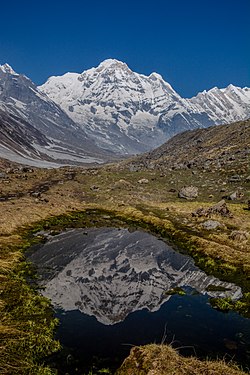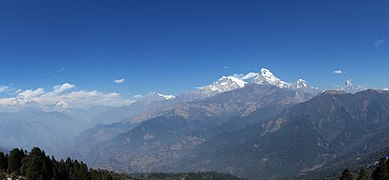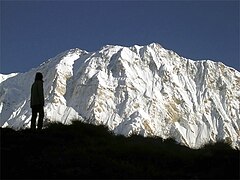Annapurna Massif
| Annapurna | |
|---|---|
.jpg/270px-South_Face_of_Annapurna_I_(Main).jpg) South Face of Annapurna I (Main) | |
| Highest point | |
| Elevation | 8,091 m (26,545 ft) Ranked 10th |
| Prominence | 2,984 m (9,790 ft) [1][2] Ranked 100th |
| Isolation | 34 kilometres (21 mi) |
| Parent peak | Cho Oyu |
| Listing | Eight-thousander Ultra |
| Coordinates | 28°35′46″N 83°49′13″E / 28.59611°N 83.82028°ECoordinates: 28°35′46″N 83°49′13″E / 28.59611°N 83.82028°E |
| Geography | |
| Location | Gandaki Zone, Nepal |
| Parent range | Himalayas |
| Climbing | |
| First ascent | 3 June 1950 Maurice Herzog and Louis Lachenal (First winter ascent 3 February 1987 Jerzy Kukuczka and Artur Hajzer) |
| Easiest route | northwest face |
Annapurna (Sanskrit, Nepali, Newar: अन्नपूर्णा) is a massif in the Himalayas in north-central Nepal that includes one peak over 8,000 metres (26,000 ft), thirteen peaks over 7,000 metres (23,000 ft), and sixteen more over 6,000 metres (20,000 ft).[3] The massif is 55 kilometres (34 mi) long, and is bounded by the Kali Gandaki Gorge on the west, the Marshyangdi River on the north and east, and by Pokhara Valley on the south. At the western end the massif encloses a high basin called the Annapurna Sanctuary. Annapurna I Main is the tenth highest mountain in the world at 8,091 metres (26,545 ft) above sea level, and was the first of the Eight-thousanders to be climbed.
The entire massif and surrounding area are protected within the 7,629 square kilometres (2,946 sq mi) Annapurna Conservation Area, the first and largest conservation area in Nepal. The Annapurna Conservation Area is home to several world-class treks, including Annapurna Sanctuary and Annapurna Circuit.
Historically, the Annapurna peaks are among the world's most dangerous mountains to climb, although in more recent history, using only figures from 1990 and after, Kangchenjunga has a higher fatality rate.[4] By March 2012, there had been 191 summit ascents of Annapurna I Main, and 61 climbing fatalities on the mountain.[5] This fatality-to-summit ratio (32%) is the highest of any of the eight-thousanders. In particular, the ascent via the south face is considered, by some, the most difficult of all climbs. In October 2014, at least 43 people were killed as a result of snowstorms and avalanches on and around Annapurna, in Nepal's worst ever trekking disaster.[6]
Annapurna is a female Sanskrit name that literally means "(She who is) Replete with food", but is normally translated as Goddess of the Harvests. According to Devdutt Pattanaik, Annapoorna devi is "... the universal and timeless kitchen-goddess ... the mother who feeds. Without her there is starvation, a universal fear: This makes Annapurna a universal goddess ... Her most popular shrine is located in Varanasi, on the banks of the Ganges River." Her association with the giving of food (wealth) led her in time to be transformed into Lakshmi, the Goddess of Wealth.[7]
Contents
Geography[edit]
The Annapurna massif contains six prominent peaks over 7,200 m (23,620 ft) elevation:
| Annapurna I (Main) | 8,091 m | (26,545 ft) Ranked 10th; Prominence=2,984 m | 28°35′42″N 83°49′08″E / 28.595°N 83.819°E |
| Annapurna II | 7,937 m | (26,040 ft) Ranked 16th; Prominence=2,437 m | 28°32′20″N 84°08′13″E / 28.539°N 84.137°E |
| Annapurna III | 7,555 m | (24,786 ft) Ranked 42nd; Prominence=703 m | 28°35′06″N 84°00′00″E / 28.585°N 84.000°E |
| Annapurna IV | 7,525 m | (24,688 ft) | 28°32′20″N 84°05′13″E / 28.539°N 84.087°E |
| Gangapurna | 7,455 m | (24,457 ft) Ranked 59th; Prominence=563 m | 28°36′22″N 83°57′54″E / 28.606°N 83.965°E |
| Annapurna South | 7,219 m | (23,684 ft) Ranked 101st; Prominence=775 m | 28°31′05″N 83°48′22″E / 28.518°N 83.806°E |
Less prominent and other peaks in the Annapurna Himal include:
- Annapurna I Central 8,051 m (26,414 ft)
- Annapurna I East 8,010 m (26,280 ft)
- Annapurna Fang 7,647 m (25,089 ft)
- Khangsar Kang 7,485 m (24,557 ft)
- Tarke Kang 7,202 m (23,629 ft)
- Lachenal Peak 7,140 m (23,425 ft)
- Tilicho Peak 7,135 m (23,409 ft)
- Nilgiri Himal North 7,061 m (23,166 ft), Central 6,940 m (22,769 ft) and South 6,839 m (22,438 ft)
- Machhapuchchhre 6,993 m (22,943 ft)
- Hiunchuli 6,441 m (21,132 ft)
- Gandharba Chuli 6,248 m (20,499 ft)
Climbing expeditions[edit]
Annapurna I[edit]
Annapurna I was the first 8,000-metre (26,200 ft) peak to be climbed.[5] Maurice Herzog and Louis Lachenal, of the French Annapurna expedition led by Herzog (including Lionel Terray, Gaston Rébuffat, Marcel Ichac, Jean Couzy, Marcel Schatz, Jacques Oudot, Francis de Noyelle), reached the summit on 3 June 1950.[8] Ichac made a documentary of the expedition, called Victoire sur l'Annapurna. Its summit was the highest summit attained for three years, until the first successful ascent of Mount Everest (although higher non-summit points - at least 8,500 metres (27,900 ft) - had already been attained on Everest in the 1920s).
The south face of Annapurna was first climbed in 1970 by Don Whillans and Dougal Haston using supplementary oxygen, members of a British expedition led by Chris Bonington that included the alpinist Ian Clough, who was killed by a falling serac during the descent. They were, however, beaten to the second ascent of Annapurna by a matter of days by a British Army expedition led by Colonel Henry Day.
In 1978, the American Women's Himalayan Expedition, a team led by Arlene Blum, became the first United States team to climb Annapurna I. The first summit team, composed of Vera Komarkova and Irene Miller, and Sherpas Mingma Tsering and Chewang Ringjing, reached the top at 3:30 pm on October 15, 1978. The second summit team, Alison Chadwick-Onyszkiewicz and Vera Watson, died during this climb.[9]
In 1981 Polish expedition Zakopane Alpine Club set a new route on Annapurna I Central (8051 m). Maciej Berbeka and Bogusław Probulski reached the summit on May 23, 1981. The route called Zakopiańczyków Way was recognized as the best achievement of the Himalayan season in 1981.
On 3 February 1987, Polish climbers Jerzy Kukuczka and Artur Hajzer made the first winter ascent of Annapurna I.[10]
The first solo ascent of the south face was made in October 2007 by Slovenian climber Tomaž Humar;[11][12][13][14] he climbed to the Roc Noir and then to Annapurna East (8,047m).[15]
On 8 and 9 October 2013 Swiss climber Ueli Steck soloed the Lafaille route[15] on the main and highest part of the face;[16] this was his third attempt on the route and has been called "one of the most impressive Himalayan climbs in history",[17] with Steck taking 28 hours to make the trip from Base Camp to summit and back again.[18]
Fatality rate[edit]
Annapurna I has the greatest fatality rate of all the 14 eight-thousanders: as of March 2012, there have been 52 deaths during ascents, 191 successful ascents, and nine deaths upon descent. The ratio of 34 deaths per 100 safe returns on Annapurna I is followed by 29 for K2 and 21 for Nanga Parbat.[5] Climbers killed on the peak include Britons Ian Clough in 1970 and Alex MacIntyre in 1982, Frenchman Pierre Béghin in 1992, Kazakh Russian Anatoli Boukreev in 1997, Spaniard Iñaki Ochoa in 2008,[19] and Korean Park Young-seok, lost in 2011.[20]
The other peaks[edit]
This section does not cite any sources. (May 2017) (Learn how and when to remove this template message) |
Gangapurna was first climbed in 1965 by a German expedition led by Günther Hauser, via the East Ridge. The summit party comprised 11 members of the expedition.
Annapurna South (also known as Annapurna Dakshin, or Moditse) was first climbed in 1964 by a Japanese expedition, via the North Ridge. The summit party comprised S. Uyeo and Mingma Tsering.
Hiunchuli (6,441 m/21,126 ft) is a satellite peak extending east from Annapurna South, Hiunchuli was first climbed in 1971 by an expedition led by U.S. Peace Corps Volunteer Craig Anderson.
Mount Machhapuchchhre (6,993 m or 22,943 ft), named after its resemblance to a fish-tail, is another important peak, though it just misses the 7,000 metre mark. Mount Machhapuchchhre and Hiunchuli are prominently visible from the valley of Pokhara. These peaks are the "gates" to the Annapurna Sanctuary leading to the south face of Annapurna I. Mount Machhapuchchhre was climbed in 1957 (except the final 50 metres for its local religious sanctity) by Wilfrid Noyce and A. D. M. Cox. Since then it has been off limits.
In winter of 2018, a climbing team of two climbers, Erik Erving (22) from America and Khalid Shwibi (23) from Jordan attempted a winter ascent of Annapurna I but were forced to turn back due to high winds and lack of necessary supplies. Following their failed attempt on Annapurna I, they attempted Annapurna IV (7,525 m or 24,688 ft) via the southeast col., but at this point had too few supplies to continue. It is also known these climbers attempted to climb without Sherpa or Porter support, further lowering the pair's chances of reaching the summit.[21][22]
Trekking[edit]
The Annapurna Conservation Area (7,629 km²) is a well known trekking region. There are three major trekking routes in the Annapurna region: the Jomson Trek to Jomsom and Muktinath (increasingly disturbed by a road-building project[23]); the Annapurna Sanctuary route to Annapurna base camp; and the Annapurna Circuit, which circles the Annapurna Himal itself and includes the Jomsom route.[24] The town of Pokhara usually serves as a starting point for these treks, and is also a good starting place for other short treks of one to four days, such as routes to Ghorepani or Ghandruk.
The Mustang district, a former kingdom bordering Tibet, is also geographically a part of the Annapurna region, but treks to upper Mustang are subject to special restrictions. Mustang is also increasingly becoming popular for mountain biking because of the construction of roads undertaken by the Nepali government in the region.
About two-thirds of all trekkers in Nepal visit the Annapurna region. The area is easily accessible, guest houses in the hills are plentiful, and treks here offer incredibly diverse scenery, with both high mountains and lowland villages. Also, because the entire area is inhabited, trekking in the region offers unique cultural exposure and experience.[25][26]
2014 trekking disaster[edit]
In October 2014, at least 43 people were killed, and some 175 injured, as a result of snowstorms and avalanches on and around Annapurna, including trekkers from Nepal, Israel, Canada, India, Slovakia and Poland. Between 10 and 50 people were thought likely to be missing.[27][28] It was believed that about 100 trekkers had left a guest house at 4,800 metres (15,700 ft), to climb to the top of Thorong La pass and then descend.[28]
The authorities were criticized for not giving sufficient warning of the approaching bad weather.[28] By 18 October, some 289 people were reported as having been rescued. An official from the Nepal Ministry of Tourism said on 18 October that helicopters were looking for survivors and bodies in snowy areas at up to 5,790 metres (19,000 ft), and were trying to reach 22 hikers stranded at Thorong La. The incident was said to be Nepal's worst-ever trekking disaster.[6]
Gallery[edit]
Millet fields in the Annapurna region play a major part in local agriculture.
See also[edit]
References[edit]
- ^ "Annapurna". Peakbagger.com. Retrieved 2009-01-12.
- ^ "Nepal/Sikkim/Bhutan Ultra-Prominences". peaklist.org. Archived from the original on 25 December 2008. Retrieved 2009-01-12.
- ^ H. Adams Carter (1985). "Classification of the Himalaya" (PDF). American Alpine Journal. 27 (59): 127–9. Retrieved 2011-05-01.
- ^ "Complete ascent — fatalities statistics of all 14 main 8000ers". 8000ers.com. June 19, 2008. Retrieved 2013-05-30.
- ^ a b c "Stairway to heaven". The Economist. May 29, 2013. Retrieved 2013-05-30.
- ^ a b "Nepal Annapurna: Climbing disaster toll reaches 39". BBC News. 18 October 2014.
- ^ Pattanaik (2009), pp. 25, 27.
- ^ Herzog, 1953, p. 257.
- ^ Blum, 1980.
- ^ "8000m Peak". summitpost.org. Archived from the original on May 19, 2007. Retrieved 2011-06-26.
- ^ "New Alpine Solo Route on the South Face of Annapurna". russianclimb.com. Archived from the original on 17 June 2011. Retrieved 2011-06-26.
- ^ "Climbing Annapurna: Tomaz Humar". Outside. January 29, 2008. Archived from the original on April 29, 2010. Retrieved 2011-06-26.
- ^ "Tomaz Humar klettert solo durch die Annapurna Südwand" (in German). Bergsteigen.at. Retrieved 2013-05-30.
- ^ Von: Text: adidas eyewear (November 26, 2007). "Tomaz Humar glückt Erstbegehung am Annapurna im Alpinstil - Climbing.de - Alle Infos für Bergsteiger und Kletterer" (in German). Climbing.de. Retrieved 2013-05-30.
- ^ a b "Annapurna South Face Routes", russianclimb.com, accessed 13 October 2013.
- ^ "Ueli Steck and Annapurna: the interview after his South Face solo", planetmountain.com, accessed 14 October 2013.
- ^ "Steck Solos Annapurna South Face", ukclimbing.com, accessed 13 October 2013.
- ^ "Annapurna South Face Solo - 28 Hours", ukclimbing.com, accessed 13 October 2013.
- ^ "It's over: Iñaki Ochoa lost on Annapurna". mounteverest.net. May 23, 2008. Archived from the original on October 15, 2009. Retrieved 2011-06-26.
- ^ Woo, Jaeyeon (October 31, 2011). "With Park Gone, Korea Loses Its Trailblazer". Korea Real Time (blog). The Wall Street Journal. Retrieved 2011-11-17.
- ^ "8000m Peak". summitpost.org. Archived from the original on May 19, 2007. Retrieved 2011-06-26.
- ^ Erving, 2018, p. 3,5,11-12.
- ^ Stacy Tasman (27 May 2011). "Nepal's shrinking Annapurna Circuit".
- ^ "Austin Pick: Circling the Abode of Snow". Archived from the original on 21 November 2008. Retrieved 2008-12-27.
- ^ "How to Hike the Annapurna Circuit". 2013-06-13. Retrieved 2016-08-23.
- ^ "Annapurna Circuit Trek". Retrieved 2016-08-23.
- ^ "Nepal trekking disaster: Britons still 'missing' after severe snow storm". The Telegraph. 19 October 2014.
- ^ a b c "Nepal blizzard: survivor tells of friends' deaths on Annapurna circuit". The Guardian. 16 October 2014.
Bibliography[edit]
- Blum, Arlene (1980). Annapurna: A Woman's Place. San Francisco, CA: Sierra Club Books. ISBN 0-87156-236-7.
- Herzog, Maurice (1951). Annapurna: First Conquest of an 8000-meter Peak. Translated by Nea Morin; Janet Adam Smith. New York: E.P Dutton & Co.
- Pattanaik, Devdutt (2009). 7 Secrets from Hindu Calendar Art. Westland. ISBN 978-81-89975-67-8.
Further reading[edit]
- Herzog, Maurice (1952). Annapurna. Jonathan Cape.
- Neate, Jill. High Asia: An Illustrated History of the 7000 Metre Peaks. Mountaineers Books. ISBN 0-89886-238-8.
- Ohmori, Koichiro (1998). Over the Himalaya. Cloudcap Press. ISBN 0-938567-37-3.
- Terray, Lionel (1963). Conquistadors of the Useless. Victor Gollancz Ltd. ISBN 0-89886-778-9. Chapter 7.
External links[edit]
| Wikimedia Commons has media related to Annapurna. |
- "Annapurna". Himalaya-Info.org (in German).
- "Annapurna". Summitpost.







.JPG/119px-South_face_of_Mount_Annapurna_(40).JPG)
.JPG/271px-South_face_of_Mount_Annapurna_(33).JPG)
.JPG/271px-South_face_of_Mount_Annapurna_(39).JPG)
.JPG/271px-South_face_of_Mount_Annapurna_(30).JPG)
.JPG/271px-South_face_of_Mount_Annapurna_(28).JPG)

.jpg/270px-Bragha%2C_Annapurna2_(4520840799).jpg)



